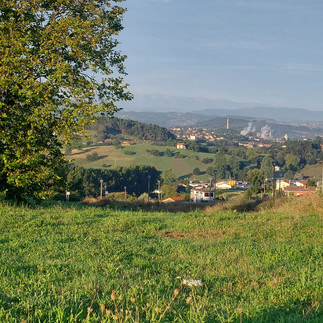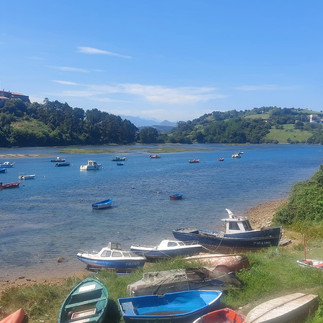Day 25: from Santander to San Vicente de la Barquera
- Magda Kirsch
- Aug 30, 2024
- 6 min read
6:30 AM: Daniega is already there. She is the wife of Felipe, who carried my (heavy) bike, of course without luggage, up three flights of stairs without an elevator yesterday. This morning, she will carry the bike down for me, she says, because Felipe had to leave early for work. I emphasize that carrying it down is much easier, and I’ll take the lead while she makes sure the back of the bike doesn’t bump into anything. Daniega and Felipe are two Colombians who came to Spain eight years ago and have started a new life here, including managing a small hotel, Elyseum, a Roman paradise – and it truly is. She tells me that everything in the kitchen is ready for breakfast and to make a packed lunch: cheese, ham, bread, jam, coffee, tea, milk... even sports nutrition for the muscles, but I decline the latter. I must emphasize again: such hospitality, kindness, and helpfulness are rare to find. Together, we bring the bike downstairs without any issues, and I depart with her encouragement, her broad smile, and her radiant look. They are doing well with their new life. It strikes me that people like these two young Colombians, and Elias, the Algerian who helped me in Santander, who have been given opportunities in another country, are eager to give something back. That’s truly wonderful.
The changing landscape and the signs indicating I am on my way to Santiago
The landscape is just like yesterday: lots of greenery and some meadows, also farmland, but no rocks. The slopes are relatively steep, but the descents make up for all the effort, both for the views and the relaxation during the ride. After two and a half hours, I reach the old village of Santillana del Mar via the N-634/N-611. I’ve been here a few times before, but this medieval village with its collegiate church – a church where a community of priests lives and works – continues to fascinate me every time. It’s clear that this village has been prosperous since the Middle Ages, first through hard work on the land and now thanks to tourism. For the first time, the church and the cloister are open to visitors, and I’m the first one there; fortunately, the large group arrives later. For a few euros, you get to see and admire a lot of art.
Santillana del mar
The collegiate church is dedicated to Santa Juliana, with her tomb in the center of the church, near the choir. She is depicted with a devil tied under her feet. She was tortured and killed by a ruler who had her tied to horses that dragged her through the streets. That’s why you also see horses in her depiction. The church is purely Romanesque, both inside and out, mainly from the 11th and 12th centuries. On the outside, there’s a beautiful loggia that provides some coolness inside, and a lovely square tower. The main entrance is on the south side, with a raised terrace, also called paradise, from which the French word ‘parvis’ is derived. The church is modestly decorated on the outside, but inside there are beautiful capitals and reliefs, including a stunning baptismal font at the back of the church, depicting Daniel being saved in the lion’s den; just as humans are saved from evil through baptism.
Santillana del mar: Yves in front of the church and the cloister
Next to it is a genuine Mater Dolorosa and an almost lifelike dead Christ in a glass coffin. Spaniards love such realistic depictions. In the front of the choir is a beautiful 16th-century altarpiece, partly painted and partly carved in wood. Naturally, it tells the story of Santa Juliana, but also that of Jesus and Mary. It’s typically Hispano-Flemish, as Flanders had true masters throughout the Camino in the Middle Ages, also in Burgos and León, not far from here. After visiting the church, I also explore the beautiful cloister, with many capitals adorned with flowers and plants, referring to the splendor of the earthly paradise, but also to Biblical stories and, I think, to Saint Juliana.
Santillana del mar: interior of the church with the tomb of Santa Juliana and the baptismal font
After a bit more than an hour, I get back on the bike and ride to San Vicente de la Barquera. On the way, I want to charge my phone and look for my power bank, but I can’t find it. Maybe it was stolen or left behind somewhere; I’m not sure. In the early afternoon, I arrive in San Vicente de la Barquera, a seaside resort on the edge of the Atlantic Ocean, basking in the sun, with a beautiful beach and lots of people. In the Middle Ages, it was a favorite stop for pilgrims, known for its hospitality and the good care provided in the hospital next to the church.
San Vicente de la Barquera
On top of the hill is a beautiful and impressive medieval castle, and a bit further on is the church of Santa María de los Ángeles. At high tide, the entire hill, on which the castle and church are located, is surrounded by the sea. There used to be a defensive wall around it, parts of which still remain. I stop at a small tavern to charge my phone and order a white wine. "1 euro," says the man kindly. I give him a two-euro coin, and he pours a large glass full. It’s a delicious local wine, dry but slightly sweet, and super refreshing. I call Magda, my brother Alain and his wife Annie, and then Geert and Fabienne, two former neighbors. Fabienne tells me that Geert, who had a thrombosis in February, is now in the process of rehabilitation and that his walking has already greatly improved. I’m overjoyed to hear that.
San Vicente de la Barquera: my pension and my laundry
After that, I eat in the park and ride to my pension, Galimar, which Magda reserved for me, on Calle Alto de Santiago – it’s almost impossible to get closer to the Camino del Norte. The pension is perched on the hill with a beautiful view of the bay and the estuary. It’s spotlessly clean, and the rooms are simple but spacious. The owner is not very friendly, but fortunately, the lady who assists me is. There are actually two Galimars: a Hotel Azul Galimar, where the fancy cars pull up, and the pension Galimar, where cyclists, walkers, and pilgrims enter through a separate entrance a bit further along. As soon as I’m in my room, I do a large load of laundry in my small bathtub and hang everything up immediately: this is also part of pilgrim life, doing laundry every two or three days and hoping it dries.
San Vicente de la Barquera: the old city wall, the church and the angel on a beam
I immediately head back into town and take a short walk to the church of Santa María de los Ángeles to visit it. In a small street, I miraculously come across an IT shop; the man has a good power bank, only 20 euros for 20,000 mAh – whatever that exactly means, but it’s enough to charge my phone several times a day. Through an old entrance door in the remains of the old city wall, I reach the church, which is quite large with three spacious Gothic naves (13th-14th century) and three beautiful 17th-century Baroque altarpieces at the front. The central altarpiece is dedicated to the Assumption of Mary into heaven by angels. On a sort of support beam in one of the arcades stands a large angel, which Rientje would surely pay a lot of attention to. He will probably talk about it in heaven. Otherwise, it’s rather austere Gothic, but it does leave an impression. On the west side of the church, there’s also a preserved part of the medieval wall of the fortress. I wander through the small streets of the old town around the castle and do some shopping along the way. The restaurants are still empty, as the Spaniards only come out at 9 PM or later, staying out very late. I eat something small in my room so I can go to bed early. Tomorrow, I’ll cycle towards Ribadesella and pass through the town of the “Indianos,” Colombres, but more about that tomorrow.

San Vicente de la Barquera: the castle














































Comments